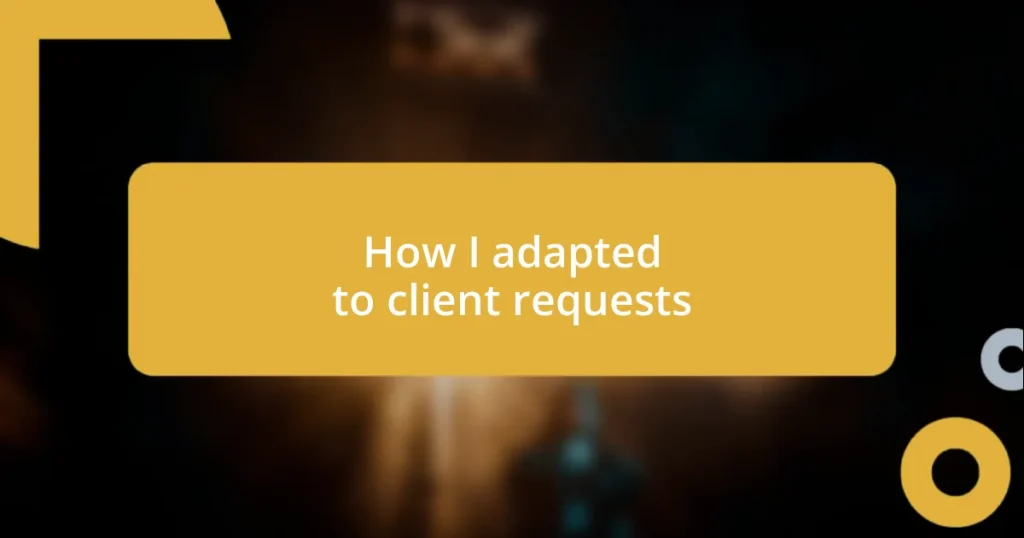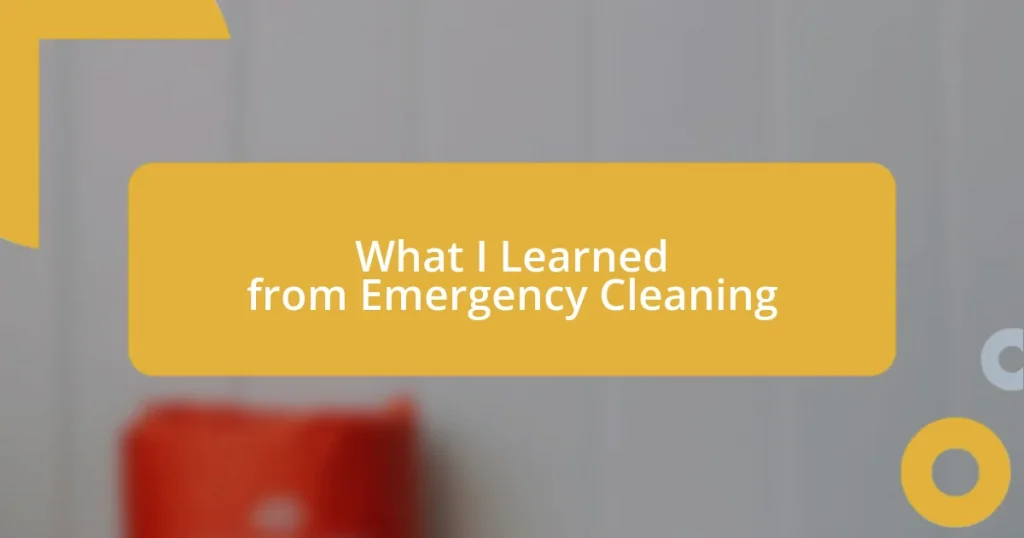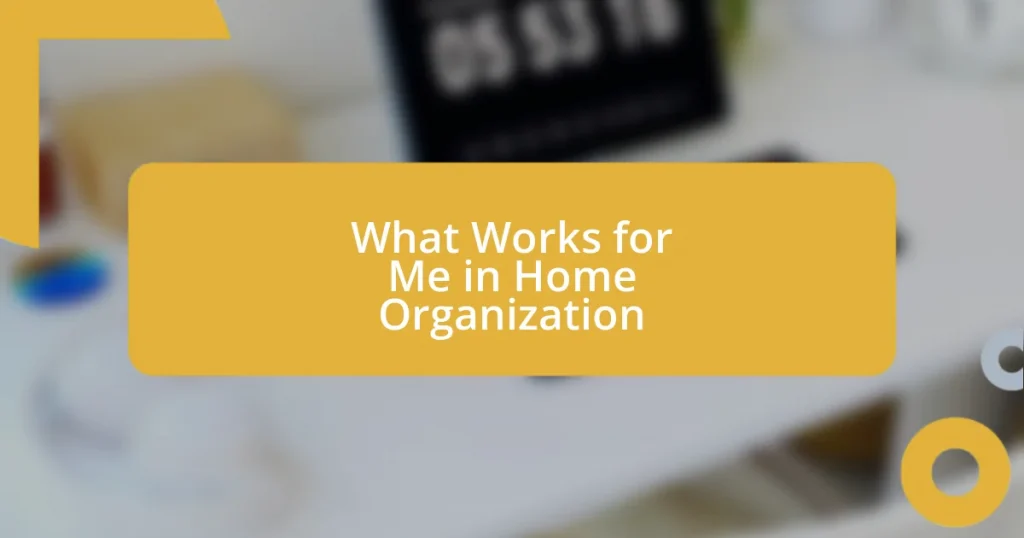Key takeaways:
- Understanding client expectations through open conversations can lead to stronger relationships and successful outcomes.
- Effective communication, incorporating active listening and regular feedback, transforms client interactions from transactional to collaborative.
- Flexibility in work processes and a willingness to embrace client suggestions can turn challenges into opportunities for innovation and growth.

Understanding client expectations
Understanding client expectations is often the cornerstone of a successful partnership. I remember a time when a client approached me with vague ideas but clear desires. It was a learning moment; I realized that asking open-ended questions could illuminate their true needs and aspirations. Have you ever had a client who seemed unsure? It’s crucial to create that safe space where they feel comfortable expressing their thoughts.
Digging deeper into expectations allows us to align our strategies effectively. Sometimes, I find myself reflecting on moments when I anticipated needs before they were voiced. For instance, one client loved visuals but hadn’t explicitly mentioned it. By showcasing engaging infographics, I not only met but exceeded their expectations, building trust along the way. This taught me that understanding goes beyond mere words; it’s about perceiving what lies beneath the surface.
Moreover, I’ve learned that transparency shape expectations significantly. During one project, I was upfront about timelines and potential obstacles. The client appreciated my honesty, and this clarity transformed their stress into understanding. It made me think—how often do we shy away from difficult conversations, fearing the response? Embracing these discussions enhances the collaboration, ultimately leading to a more satisfying outcome for both parties.

Building effective communication
Effective communication is the heartbeat of my client relationships. I recall a project where our first meeting was filled with misinterpretations and nods without clarity. Recognizing the disconnect, I made it a point to summarize key takeaways at the end of our discussions. This simple strategy transformed our meetings into productive collaborations rather than a series of vague exchanges. I learned that sometimes, silence can be just as revealing as words—it’s essential to check in and encourage feedback.
To foster a deeper connection with my clients, I focus on these communication strategies:
- Active Listening: I genuinely listen to what my clients share, picking up on non-verbal cues and emotions.
- Clarifying Questions: I always ask questions to ensure I fully understand their perspectives and expectations.
- Regular Updates: I provide frequent progress updates to maintain transparency and keep them involved in the process.
- Feedback Loop: I encourage an open dialogue for feedback, allowing clients to voice their thoughts and concerns without hesitation.
- Tailored Communications: I tailor my communication style based on individual client preferences, catering to their unique ways of processing information.
In my experience, these practices have transformed relationships from transactional to collaborative, and that’s truly rewarding.
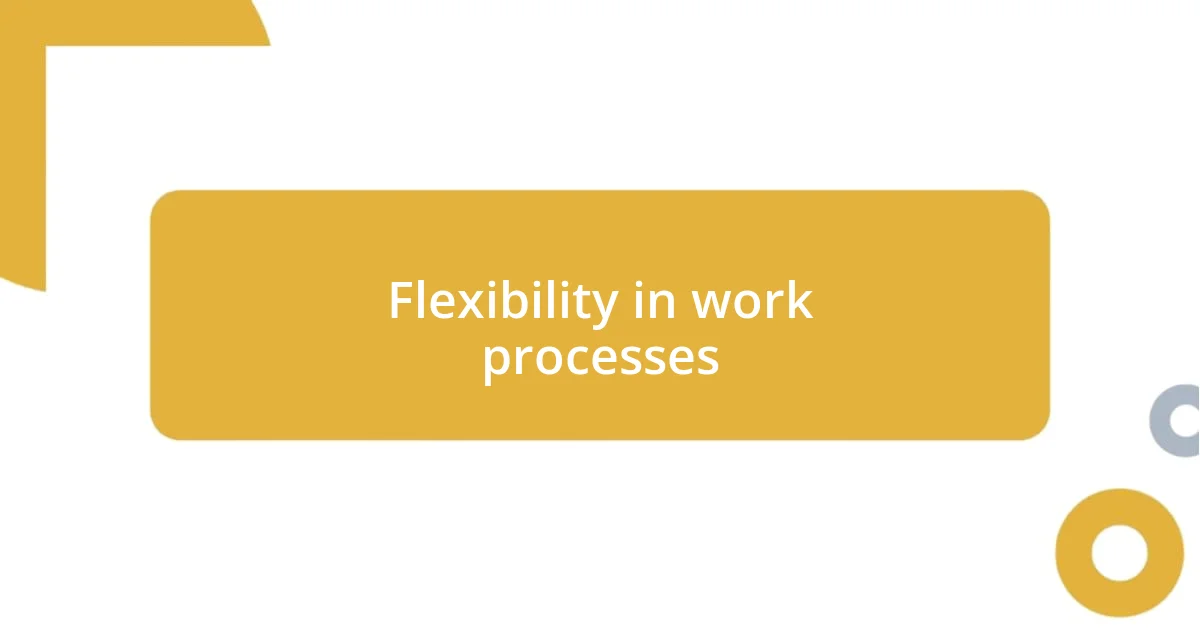
Flexibility in work processes
Flexibility is an essential element in any work process, especially when it comes to adapting to client requests. I recall a time when a client suddenly shifted their project scope just a week before the deadline. Instead of viewing it as a setback, I took a moment to breathe and reassess my workflow. I quickly realigned my priorities and adjusted my approach, which not only helped me meet their new requirements but also reinforced my adaptability. Have you ever found yourself in such a tight spot? It’s incredible how a little flexibility can turn challenges into opportunities.
In my experience, being flexible often means embracing a trial-and-error mindset. There are instances when I’ve had to pivot my strategies based on real-time feedback from clients. One particular client expressed frustration with a design draft that didn’t resonate with their vision. Instead of feeling defeated, I welcomed their input and modified my approach, incorporating their suggestions into the next iteration. This not only strengthened our collaboration but also enriched my creative process. Flexibility, I believe, is about cultivating a willingness to change and innovate, ensuring that I’m aligned with my client’s evolving needs.
In today’s fast-paced environment, a rigid approach can be detrimental. I remember juggling multiple projects when one client requested a complete overhaul of their marketing campaign. Rather than letting my existing workload overwhelm me, I delegated tasks effectively and created a plan that accommodated their request. Implementing that plan not only showed my capability to adapt quickly but also reinforced the relationship we had built. Flexibility in work processes empowers me to navigate the unexpected, proving that sometimes the best outcomes arise from a willingness to bend.
| Traditional Approach | Flexible Approach |
|---|---|
| Rigidity in processes | Adaptable to change |
| Strict timelines | Dynamic scheduling |
| Resisting feedback | Embracing client input |
| Overcommitment | Delegation and collaboration |

Using feedback for improvement
Using feedback effectively has become a cornerstone of my professional growth. I remember a time when a client provided feedback on a proposal that I had poured my heart into. At first, I felt defensive, but I took a step back and really listened. This client was expressing concerns that were rooted in their experience, and I realized that this was an opportunity for improvement rather than a critique. Embracing their feedback led me to refine my approach, resulting in a proposal that met their expectations and even sparked excitement. Have you ever felt that rush of understanding when feedback transforms your initial vision?
Encouraging feedback from clients has reshaped my entire workflow. I’ve made it a habit to actively solicit their insights at every stage of a project. For instance, after presenting a draft, I would ask, “What resonates with you?” or “How can we make this better?” This strategy not only fosters trust but also invites collaboration. I can’t stress enough how eye-opening it is to view a project through your client’s lens. The more I ask, the deeper my understanding grows, creating a partnership that feels aligned and invested.
One memorable experience solidified my belief in the power of feedback. During a branding project, a client expressed that the initial direction I took felt off-brand. Instead of dismissing their feelings, I dove into a discussion, exploring their vision further. This interaction revealed valuable insights that allowed me to pivot the project completely. The end result was a brand identity that truly resonated with them, and I felt a profound sense of accomplishment. Feedback, in my view, isn’t just a tool for refinement—it’s a bridge to deeper client relationships. Have you ever turned a challenging conversation into a breakthrough moment?

Implementing client suggestions
Implementing client suggestions can dramatically reshape a project’s trajectory. I once worked on a website redesign when a client suddenly wanted to overhaul the entire navigation structure based on their user research. Instead of balking at the extra work, I leaned into their expertise and took the time to understand their perspective. By collaborating closely, we transformed what could’ve felt like an obstacle into an opportunity for innovation.
There was a project where a client asked for color palette changes halfway through the development phase. My first instinct was to push back, worried about the impact on timelines. But then I reminded myself of the importance of client input, and I decided to embrace the change. Not only did we create a fresh look that aligned with their vision, but this willingness to adapt strengthened our relationship. Isn’t it intriguing how responding positively to suggestions can lead to growth for both parties?
Sometimes, it’s the smallest tweaks that create the biggest impact. I remember when a client suggested adding a testimonial slider to their landing page. Initially, I was skeptical about its effectiveness, but I decided to implement it anyway. To my surprise, it boosted engagement significantly! That taught me to remain open-minded. Have you noticed how some of the best ideas often come from collaboration? Implementing client suggestions, even if they deviate from the original plan, can lead to delightful breakthroughs.

Maintaining professional relationships
Maintaining professional relationships requires a careful balance of empathy and understanding. I recall a time when a client experienced a personal challenge that affected their project timeline. Instead of simply enforcing deadlines, I chose to reach out and express my support. I learned that showing genuine care not only strengthened our bond but also allowed for more open communication moving forward. Have you ever experienced a moment when empathy shifted the dynamics of a working relationship?
Effective communication is the glue that holds professional relationships together. I found that regular check-ins, even when there’s no pressing issue, help keep the lines open. For instance, I often schedule brief calls to discuss project progress. During one such chat, we ended up brainstorming ideas that ultimately enhanced the project. This simple act of connection not only reassured the client but also made them feel involved in the process. Don’t you think that consistent engagement makes clients feel valued and respected?
Overall, it’s the trust built through transparency that truly sustains these professional relationships. I remember collaborating with a client who was hesitant about a strategic shift. By honestly sharing my insights and the rationale behind my recommendations, we reached a mutual understanding that emerged from respect and honesty. That experience reinforced my view that being transparent cultivates an atmosphere where clients feel comfortable expressing their thoughts. Have you discovered how honesty can create a solid foundation for lasting partnerships?
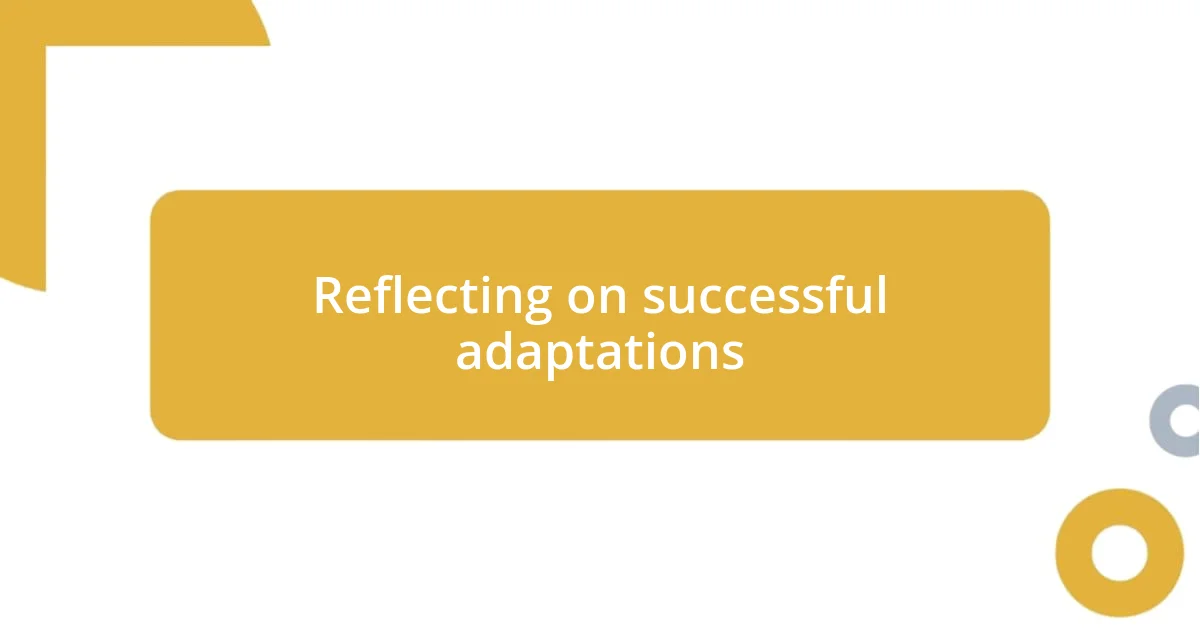
Reflecting on successful adaptations
Reflecting on successful adaptations often brings to light the unexpected joys of collaboration. There was a project where a client proposed a new feature that I initially thought was unnecessary. However, after engaging in a candid conversation, I discovered their reasons were rooted in genuine user needs. This allowed us to pivot our focus, resulting in a product that not only satisfied the client but also resonated deeply with their audience. Isn’t it amazing how a simple discussion can lead to a breakthrough?
One remarkable adaptation involved learning to embrace technology that I wasn’t entirely comfortable with. A client encouraged me to integrate a new project management tool that streamlined our communication and task tracking. At first, I hesitated, feeling overwhelmed by the learning curve. However, pushing past that discomfort opened doors to improved efficiency and clarity in our workflow. Have you ever had a moment where stepping out of your comfort zone led to surprising benefits?
Additionally, I often find that recognizing the emotional aspect of client requests is crucial to successful adaptations. During one project, a client revealed they felt undervalued due to past experiences with another vendor. This insight prompted me to actively involve them in decision-making. By prioritizing their concerns and preferences, I not only adjusted our approach but also fostered a partnership built on trust. Do you feel that understanding the emotional context can significantly enhance professional relationships?










